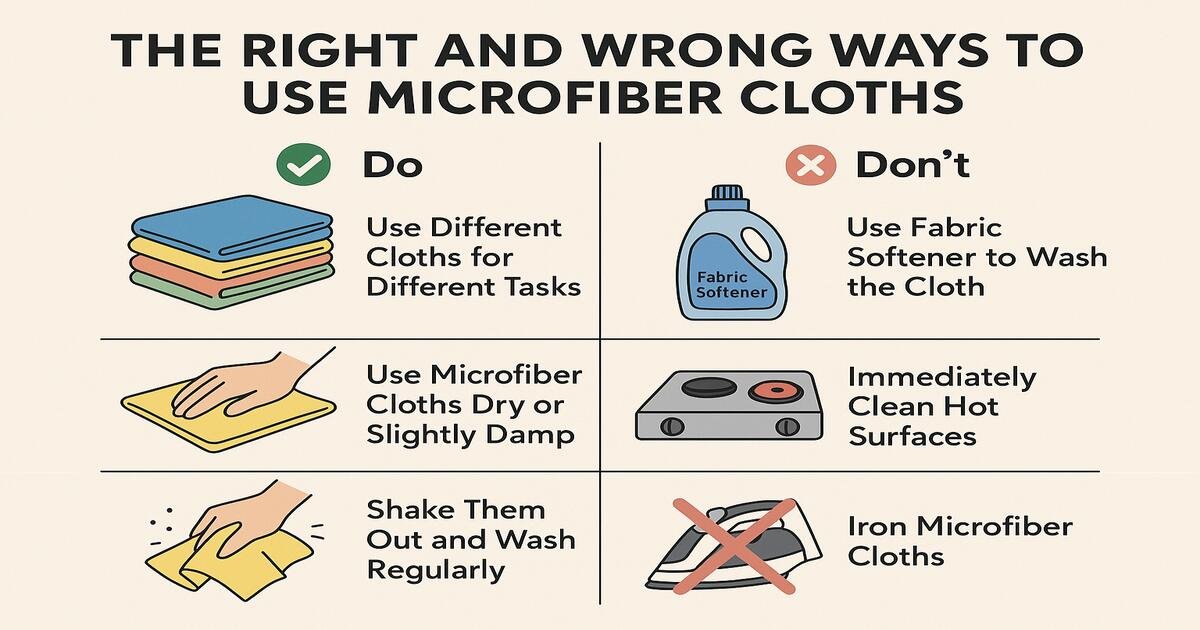The Right and Wrong Ways to Use Microfiber Cloths for Cleaning
Have you ever wondered about your microfiber cloth’s inability to pick up dust anymore? Or, is it an additional observation that it seems to smear rather than clean? Microfiber cloths are often touted as miracle cleaning implements, and fairly so! They are reusable, environmentally friendly, and can pick up dirt entirely on their own without any chemicals. But herein lies the rub: if you are abusing and neglecting them, they will soon be rendered powerless in your hands.
Which is why it is paramount to know the dos and don’ts of microfiber cleaning. The way you treat them on different surfaces and wash, and store them is the delightful details that make a world of difference. In this blog, we will illustrate the rules suggested by End of Lease Cleaning in Gold Coast that you must live by and what to avoid at all costs to make the best use of microfiber cloths. Irrespective of whether you are a cleaning guru or still in the early stages, this will help you clean smarter, not harder.
1. Do: Use Different Clothes for Different Tasks
Using dedicated microfiber cloths for various cleaning tasks is as intelligent as it gets, often colour-coded for different cleaning jobs for bathrooms, kitchens, or wet and dry surfaces. These measures ensure that no cross-contamination occurs and hygiene remains at top levels throughout the whole house.
Many professional cleaning companies, on the other hand, advise using different cleaning rags for cleaning different areas, to keep the cleanness of your premises, to maintain a clean record of your premises, especially when it comes to end-of-lease cleaning.
2. Don’t: Use Fabric Softener to Wash the Cloth
Fabric softener adds a pleasant fragrance to wash water, but it’s like a death sentence for the microfiber cloth. There are chemicals applied to the fibres so that the fabric does not impart any binding to dirt and absorbency to liquids, thereby decreasing performance and generally killing the microfiber cloth with every wash.
Wash your microfibre cloths with a mild detergent without softener. Use cold or warm water and air dry or tumble dry on low to prevent damage. Proper care ensures that your clothes remain fluffy, absorbent and effective for all cleaning jobs, just like those of the pros.
3. Do: Use Microfiber Cloths Dry or Slightly Damp
The versatility of microfiber cloth is one of its best features. It does an excellent job when used dry and wet. Dry towels are used to dust since the fibres are normally able to develop static electricity to pick up and hold the dust particles. To enhance the cleaning of stubborn stains, slightly dampen the cloth with water; there is no need to apply any chemical.
Dirt and fingerprints, and smudges can then be easily wiped off most surfaces with a damp microfiber cloth, and there will be no need for sprays that may leave a residue. This eco-friendly cleaning system is favoured by professional cleaners due to its ability to produce a streak-free finish with little chemical use.
4. Don’t: Immediately Clean Hot Surfaces
Clean microfiber cloths may be thick, but exposure to high temperatures will melt or warp them. So much so that they are not to be used immediately after fixtures like stovetops, ovens, or toasters have been used. Such extremes in at temperaures break down the synthetic fibres, which make the cloth less useful in the long run.
Hold off on turning on the moist microfiber cloth until the appliance cools. Your patience will not only spare in damage to the cloth but will also help it perform better in the long run.
5. Do: Shake Them Out and Wash Regularly
It is often forgotten, but shaking out one’s microfiber cloth after each use is instrumental for decontaminating the surface. This simple act helps to dislodge any dirt or debris held in the cloth, thus reducing scratches on doctor’s glass surfaces, mirrors, or stainless steel. A clingy cloth full of grit can do damage rather than good in such cases.
Regular washing, together with shaking, keeps these clothes working at their optimum. Dirty deposits accumulate and block the fibres, rendering them ineffective. Just a few seconds after every use, shake well, and after a few uses, toss into a proper wash cycle.
6. Don’t: Iron Microfiber Cloths
Ironing microfiber cloths is an absolute no-no. Intense heat from an iron can easily melt the very fine fibres to render the cloth useless. Although ironing seems to be the fastest way to either dry or sanitise, it only destroys the fine structure and function of the cloth.
Rather, air dry or tumble dry on very low settings if you want them dry quickly. These drying techniques keep microfiber cloths longer in life and at the same time get them ready for any cleaning job, with the frequency varying from daily to professional service cleaning.
Conclusion
A microfiber cloth is a mighty cleaning partner-but only provided it is appropriately used and maintained. The do’s must always be followed: using separate cloths for varying areas, washing them without fabric softener, and properly storing them; this ensures they are kept effective for longer periods. On the other hand, making sure to omit those that will damage the clothes and surfaces-potentially huge mistakes: using on hot surfaces, mixing with linty laundry, working with highly concentrated cleaning solutions-will repay in your favour.
When well taken care of, microfiber cloths can cut cleaning time down drastically while giving squeaky-clean results. Dusting windows, polishing furniture, or scrubbing kitchen counters- anything goes with these cloths as long as you treat them well. So, clean confidently and efficiently, knowing you are using one of the top tools in the game in the right way. Your home and your microfiber cloths will thank you.

